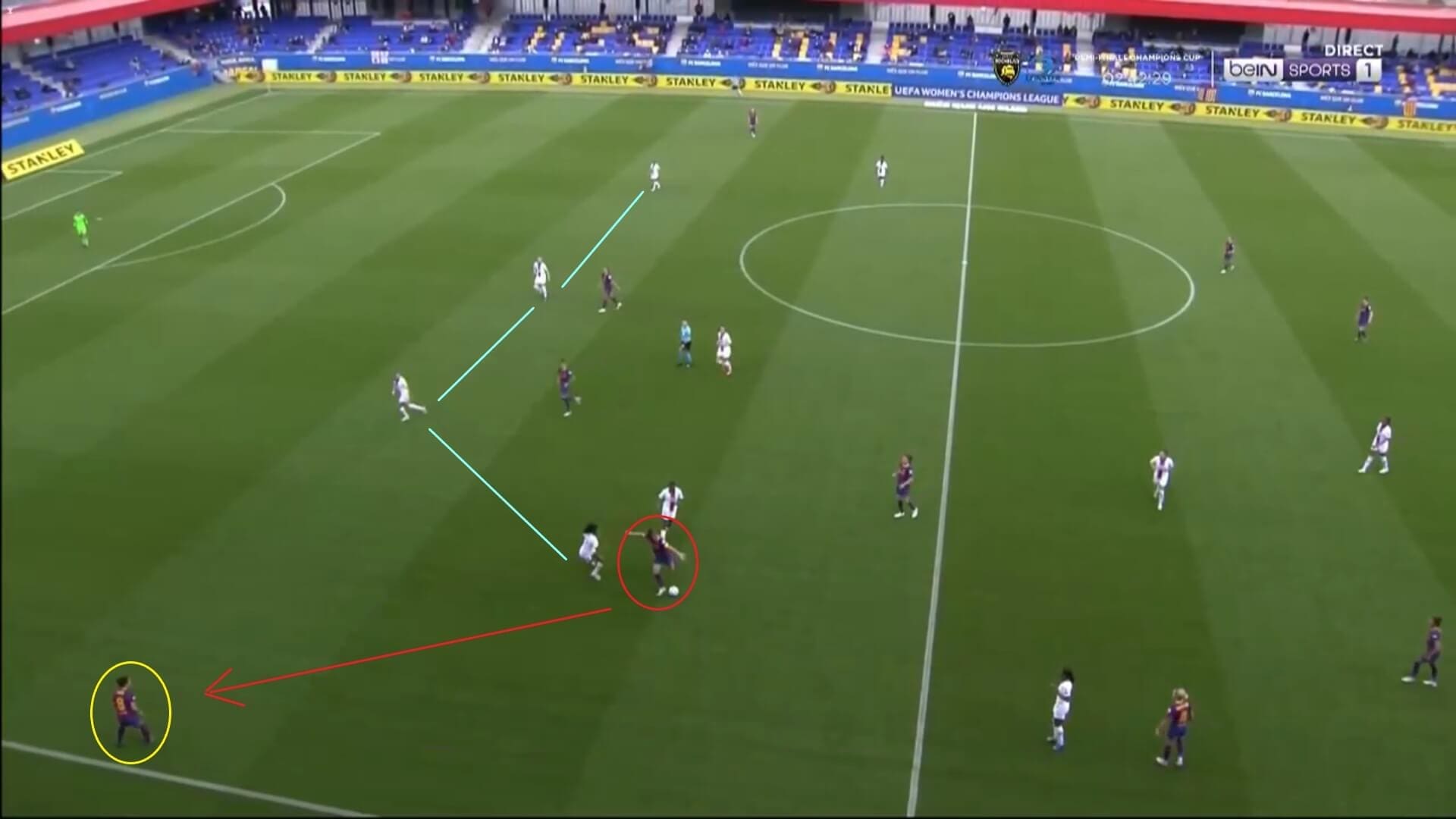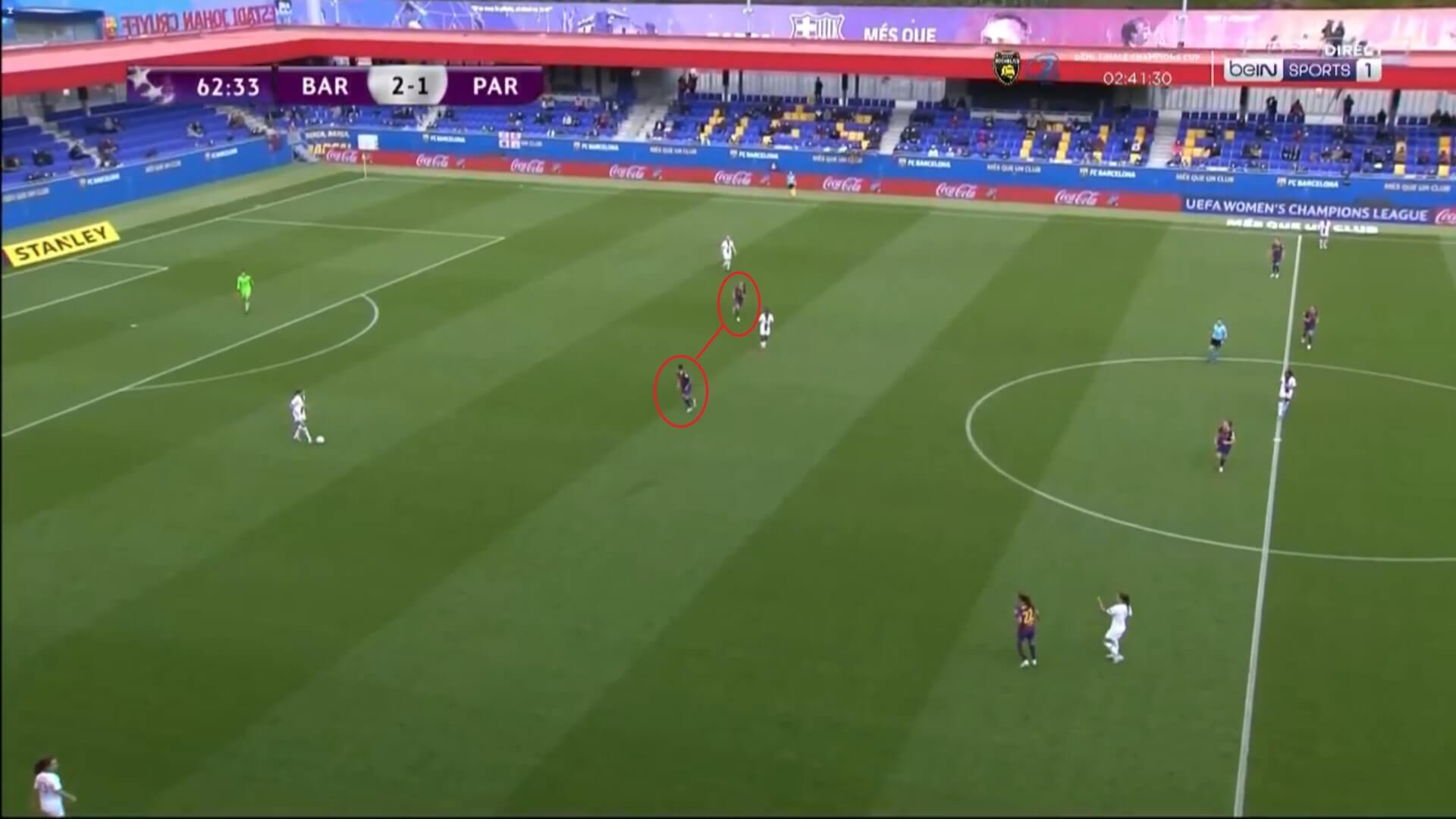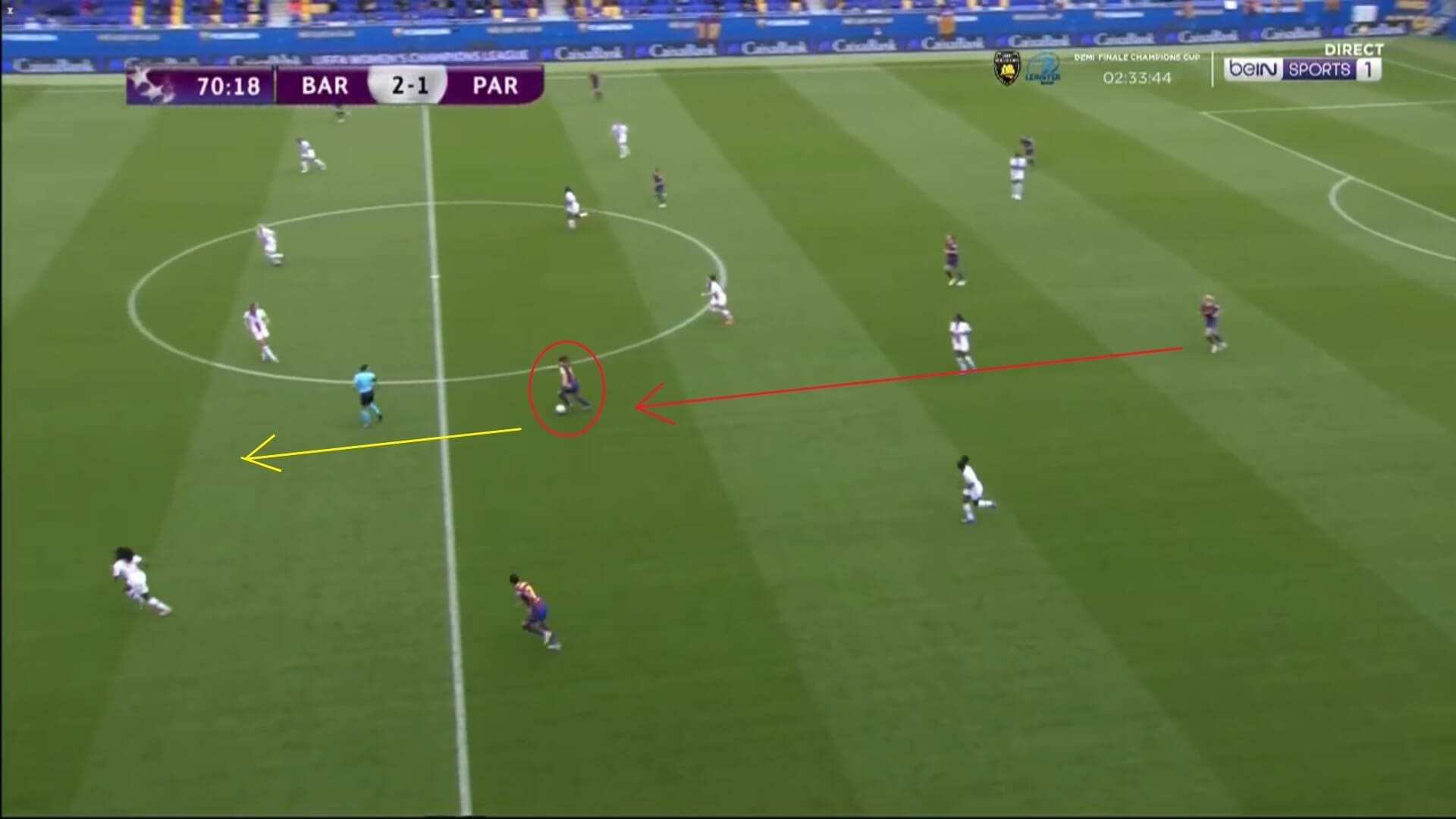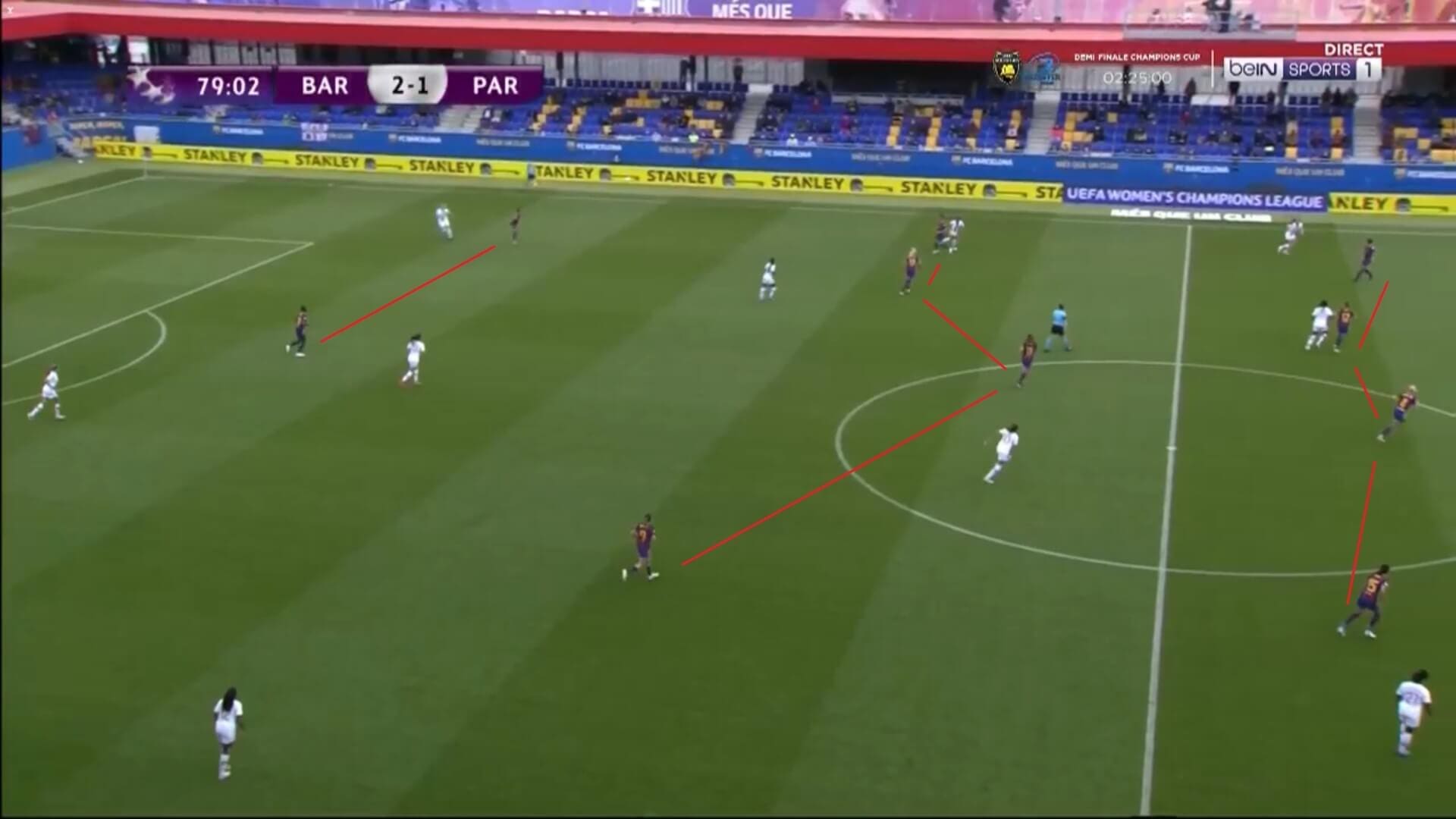Sunday afternoon saw the second legs of the two UEFA Women’s Champions League semi-finals take place, with Chelsea Women hosting Bayern Munich at Kingsmeadow, whilst Paris Saint-Germain Feminine travelled to Barcelona Femeni. Both ties were still wide open, with all four teams in with a chance of progressing to this year’s final. In this tactical analysis, we will look at the latter of the two games, focusing on PSG’s continuous mistakes and Barcelona’s attacking tactics and structural adaptability.
Lineups

Barcelona Femeni made 10 changes from the side that defeated Madrid CF last Wednesday, with only club vice-captain Alexia Putellas keeping her spot. That meant that the Spanish side resorted to the same team that drew in Paris in the first leg, with the likes of Marta Torrejon, Mapi Leon, Caroline Graham Hansen, Aitana Bonmati, Lieke Martens and Jennifer Hermoso all coming in. There was just one change from the starting XI in the first leg, with Patricia Guijarro returning from suspension to play in the hole; France midfielder Kheira Hamraoui moved to the bench as a result.
PSG Feminine, meanwhile, only changed one player from the first leg, having had the whole week to recover and prepare for this match. France forward Kadidiatou Diani had not recovered in time to feature, so Switzerland and former Chelsea forward Ramona Bachmann came in to play on the right side of the attack. USA defender Alana Cook, who had scored the equaliser in Paris, made way for her, with Canada international Ashley Lawrence reverting to her favoured right-back position. Grace Geyoro and Germany international Sara Dabritz again partnered each other in midfield, whilst Marie-Antoinette Katoto was preferred upfront to Danish duo Nadia Nadim and Signe Bruun, both of whom were on the bench.
PSG Feminine’s mistakes
PSG Feminine created plenty of good opportunities in the first leg, but lacked the essential quality to convert them when in the final third. Couple that with the mistakes they made, and we can see why they generally struggled to get into the game.
In the second leg, those mistakes continued, demonstrating how they hadn’t learnt their lessons in some situations.

Barcelona Femeni’s first leg goal came when PSG left-back Perle Morroni moved too far out of line, giving the Spanish side the space to attack behind her. In this image, we can see how the exact same thing has happened, with Ashley Lawrence this time advancing too far forward, looking to close the ball down.
Whilst Torrejon, in the yellow circle, manages to get behind the defence here, the opportunity breaks down before anything can come of it. However, Lieke Martens did the same thing in the first half, with Lawrence losing line discipline and leaving the space open behind her; this led to the first goal of the game for the home side. Therefore, it was the same issue for PSG, as they allowed Barcelona to manipulate them and to move the ball into dangerous areas of the pitch.

The away side were also careless when passing the ball around the pitch, with a visible lack of quality preventing them from gaining any momentum. In this image, Brazilian midfielder Formiga is unable to control the pass from her teammate, knocking it behind her for Hermoso to meet and drive forwards with. Martens is partnering her in a front two at this point, and, with Putellas running through the middle, PSG are now in a three-v-three defensive situation, all because they gave the ball away too easily.
This is only one example of a mistake PSG made, but they were a constant feature of their play, and they need to have more composure when moving the ball around the pitch.

Despite this, PSG did create some good chances in attack, with the decision to start Ramona Bachmann a good one. The Switzerland international constantly got into promising positions in the final third, looking to give her teammates passing options, and generally increased the pace of their final third play. However, PSG still couldn’t turn any of these opportunities into shots or goals, with Bachmann’s ground pass not met by any of her teammates in the middle here.
Therefore, whilst they were determined and never gave up, PSG never looked like winning this game. They have a good presence on the pitch, and can cause problems for their opponents, but need to work on the finer details if they want to make the step up to win these games.
Barcelona Femeni’s attacking tactics
Despite PSG Feminine’s errors, it was not an easy game for Barcelona Femeni, and they had to work hard to win this second leg. One area the Spanish side thrive in is attack, and their final third play was again a major factor in their eventual win.

They always look to get on the front foot early, continually pressing PSG’s players and trying to force a mistake. Hermoso and Aitana Bonmati have formed a front two, shown by the red line, with Putellas coming forward to close down the defender, as the arrow indicates.
PSG were under relentless pressure at the back, and it showed, with some of their aforementioned mistakes coming from them trying to keep the ball when being closed down. Barcelona are a very well-drilled and well-coached side, with every player knowing when it was their turn to close the ball down, and this again helped them to control the game.

It didn’t matter who was up in attack, or what stage of the match they were in; Barcelona were always on the front foot. However, in the second half, they weren’t closing the ball down so much, with the front two here working together to drift across the pitch, shadowing the ball and stopping PSG playing it forwards. Instead, the away side were forced to pass sideways, so Barcelona controlled the game here without exerting too much energy, which was really clever from them.
To further prevent PSG playing forwards, Barcelona surrounded their midfield passing options, so it was clearly something they had discussed at half-time as a way of maintaining their pressure in the second half, not allowing PSG to grow into the match as they had done after half-time in the first leg encounter.

Barcelona also used the wings well, with a lot of their attacking play going down the right-hand side in particular. PSG defended very narrowly, trying to stop Barcelona’s key attacking players finding spaces to run through, so the home side attempted to stretch them out by positioning their wide forwards as close to the sidelines as possible. However, when that didn’t work, Barcelona instead used the open spaces on the wings to create opportunities in the middle.
This image shows Norway forward Hansen in this space, looking to set up an opportunity in the middle for a teammate. This is the build-up to the second goal, so we can see how Barcelona’s spatial awareness helped them create good attacking chances.

Despite being up in the tie, Barcelona never pushed their luck, instead sticking to what they know. One of their key qualities is passing through the thirds, taking care of the ball when in transition. In the first leg, some of their passes went astray, but they were much better in this game. Putellas, in the red circle, has received the ball from her teammate here, before turning and dribbling forwards, as the yellow arrow shows. The fact that she takes the ball to the edge of PSG’s box shows how basic tactical play was essential to Barcelona’s win, especially as an interception and subsequent goal for PSG would have taken the French side into the final.
Barcelona Femeni’s changing formations
However, the biggest reason for their success this season has been an ability and willingness to adapt to different situations. In matches, we will often see them change formations and structures two or three times, always looking to play in a way that fits what is happening in the game.

We have already mentioned how they positioned players as close to the sidelines as possible. This was sometimes the wide forwards and sometimes the full-backs, but the result was the same; Barcelona had options to help them get behind PSG’s defence. We can see how it effectively gave the home side a front four setup as well, ensuring their forward line ran across the pitch. This gave PSG’s defence a decision to make; they could either stretch out to cover the wide spaces, but leave gaps open in between individual players, or they could stay central and let Barcelona attack down the wings. Therefore, at this point, Barcelona were focusing on their attacking play, looking to create goalscoring opportunities.

However, they can also be more defensively-minded when needed, as we see here. At this point, Kheira Hamraoui had replaced centre-back Andrea Pereira, with Patricia Guijarro slotting into defence and Hamraoui coming into midfield. This gave them a 4-4-2 setup, allowing them to continue pressing at the front, but also to close the gaps between the midfield and defence, ensuring that PSG’s attackers couldn’t access those spaces. To give them added energy in this setup, former Liverpool Women and Arsenal Women striker Asisat Oshoala had come on to partner Hermoso upfront, whilst wide attacker Mariona Caldentey had replaced Martens, taking the Dutch international’s position on the left side of the midfield four.
Therefore, they have adapted their setup from a front four to a front two, bringing more players back to block the gaps, knowing that their focus has to now be on stopping PSG scoring.

They can also play with a single striker in attack, as this image shows. This comes from the final minutes of the game, so it was clear that they were looking to play with a more counter-attacking approach here, just as they did in the first leg when they wanted to protect their goal.
Hermoso and Oshoala are different types of strikers, and this image highlights that difference. Whilst Hermoso likes to drop into midfield, as she has here, allowing the likes of Putellas and Bonmati to get up the pitch and lead the line, Oshoala is much more of an out-and-out striker, preferring to stay high up the pitch and be the target player for when her teammates get the ball further back. Here, she has been released behind PSG’s defence, but can’t make the chance count. However, having one striker at the top of the pitch is a third way that Barcelona can play in attack, and further shows their ability to adapt to the way the game is going.
Conclusion
In conclusion, this tactical analysis has shown how Paris Saint-Germain Feminine made the same errors in the second leg as they did in the first, giving Barcelona Femeni plenty of opportunities to attack the space behind them, as well as lacking quality in the final third. Barcelona, meanwhile, came into this game with a clear plan for how they wanted to play at each point of the match, which is what helped them to remain organised and an effective threat throughout. It was notable that they scored with their first two shots on target, so were more clinical than their opponents. They did make mistakes, with PSG’s goal coming from a mix-up in the box, but the overall quality that Barcelona have will make them strong contenders against Chelsea in the final, and it will be intriguing to see if Chelsea learn from PSG’s performances to ensure that they don’t go the same way as the French side.





Comments